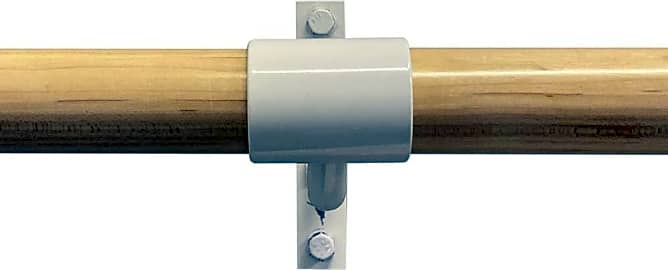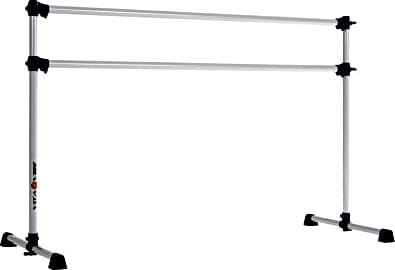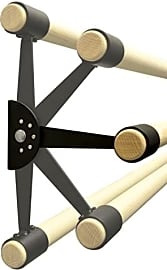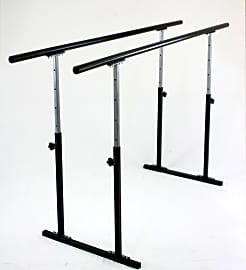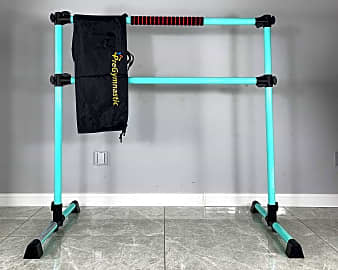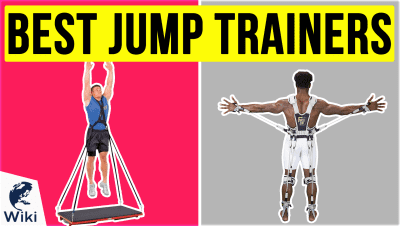The 6 Best Ballet Barres

This wiki has been updated 38 times since it was first published in April of 2015. Budding Barishnikovs and Pavlovas may want to add one of these ballet barres to their practice routine, but they also make a great addition to your home exercise studio. Whether you're replacing your monthly class subscription with a convenient in-home workout or taking your dance training to a whole new level, our list includes everything from light and portable to permanent wall-mounted options. When users buy our independently chosen editorial choices, we may earn commissions to help fund the Wiki.
Editor's Notes
April 14, 2020:
For this update we added a more wall-mounted options like the Vita Vibe Hinged and the Custom Barres Pro due to the popularity of the barre workout trend with exercises that require the barre to support more weight than a true ballet workout. They are a great option for a home studio.
We like the Vita Vibe Hinged better than the brand's traditional fixed mount option because you get the stability of a mounted barre, with the option to vary it's height without making any new holes in the wall, plus you can adjust it flush with the wall to save space.
The portable choices will always be the best fit for many families and are completely safe provided that they are used for ballet practice and not as a climbing apparatus. Proper ballet exercises use the barre for balance and stretching and should never hold a dancer's entire weight.
Barres like the Pre Gymnastic 4 Foot are great for younger dancers, but should be used with supervision until the child is mature enough not to try and hang from it.
We added the Artan Balance Square Double in the top spot because the base makes it difficult to tip, plus adjusting the barres is simple and easy.
Special Honors
Harlequin Floor-Mounted The makers of some of the best floors in the business can also provide you with professional-quality floor-mounted barres if you don't want to make holes in the walls, or you want a fixed barre on the same wall as a mirror. Their sturdy portable barres include adjustable feet, should be dancing on uneven floors. harlequinfloors.com
Boss Barre Pro For heavy daily usage by multiple dancers, the Boss Barre Pro offers the stability of a wall-mounted option in the strongest free-standing barres available. Offered in sizes from 8 to 14 feet, they are built to last and will serve many dancers at once. While they are portable, these thick steel options will take two people to move around. balletbarresonline.com
The Benefits Of A Ballet Workout
If you are new to dance, or if it's been years since your childhood ballet training, consider taking a class to ensure you are using proper technique.
Ballerinas are revered for their astounding blend of grace and athleticism. Superior strength and flexibility are often the keys to making the most difficult steps look effortless. Ballet barre workouts are quickly becoming one of the hottest exercise trends, with studios popping up in strip malls promising to tone your muscles and give you a dancer's physique. The truth is, it will take more than a few barre workouts to sculpt a dancer's body, but incorporating a ballet barre into your regular workout regimen is a great way to spice up a boring routine, while stretching and strengthening muscles you didn't even know you had.
One of the most important, but often neglected, aspects of fitness is flexibility. Ballet barres are better than stretching on a chair or other piece of furniture because they are designed for stability and are the correct height for many exercises that can enhance flexibility and strength. If you are new to dance, or if it's been years since your childhood ballet training, consider taking a class to ensure you are using proper technique. Bad form at the ballet barre can quickly lead to strained muscles that are often the precursor to more serious injuries.
Like Pilates and yoga, many of the moves will focus on improving your core strength while improving flexibility. A typical ballet workout consists of poses held in isometric contraction and small, repetitive movements that result in lean, toned muscles. If you pay attention to proper form, you'll get the added benefits of improved posture and spinal alignment.
Choosing the Right Ballet Barre
Whether you are outfitting a new dance studio or just looking to add variety to your everyday workouts, investing in a ballet barre can be a big decision. The most important things to consider are space constraints and how much portability, if any, you need.
These barres are often wooden, but include heavy metal brackets to ensure they are stable enough to support your weight.
The most stable and inexpensive barre is the classic, wall-mounted variety, but it could be costly to mount correctly if you need a handyman to help you install it. These barres are often wooden, but include heavy metal brackets to ensure they are stable enough to support your weight. An added benefit of wall-mounted barres is that they take up no floor space. However, they are much harder to move, and you will also have no flexibility when it comes to height.
The correct height for a ballet barre should fall somewhere between the hip and waist. Many portable barres offer the advantage of having adjustable height, which can be helpful if multiple age groups or family members will be using the same barre. The primary disadvantage of a portable barre is the large amount of floor space they take up. Proper barres have wide feet and are heavy enough to provide the stability needed to prevent tipping and moving. To help save space, look for portable barres with feet that can be turned parallel to the barre for easy storage against a wall.
When choosing the length of your ballet barre, keep in mind how many people will be using it at the same time. It is necessary to have three feet of space between dancers so that they cannot kick one another. Wall-mounted barres can occupy the entire length of a room without taking up any precious floor space, but keep in mind that portable barres can be used on both sides if placed far enough away from the wall while in use.
A Brief History Of Ballet
The origins of ballet can be traced to the early Italian Renaissance where it began as a form of court entertainment for royalty. During the 15th and 16th century, the art form slowly evolved into the more formal techniques still used today. When the Italian aristocrat Catherine de Medici married the French King Henry II, she introduced what became a long tradition of court ballet to France.
When the Italian aristocrat Catherine de Medici married the French King Henry II, she introduced what became a long tradition of court ballet to France.
Over the next 100 years, the official terminology of ballet was codified in the French language. This chapter of ballet history reached its peak when Louis XIV, a dancer himself, established two French ballet academies in the mid-17th century. One of these academies was the predecessor to the famed Paris Opera Ballet.
Ballet didn't become part of Russian culture until the early 18th century after the tsarist royal family under Peter the Great began to open its borders to western influence. The Imperial Ballet paid great attention to the training and technique of its dancers, leading to the disciplined style that Russian ballet is known for today. By the late 19th century, Russia was a major creative center for ballet dancers and composers. During this time many ballets were composed that remain classics today, including the works of Peter Ilyich Tchaikovsky.


